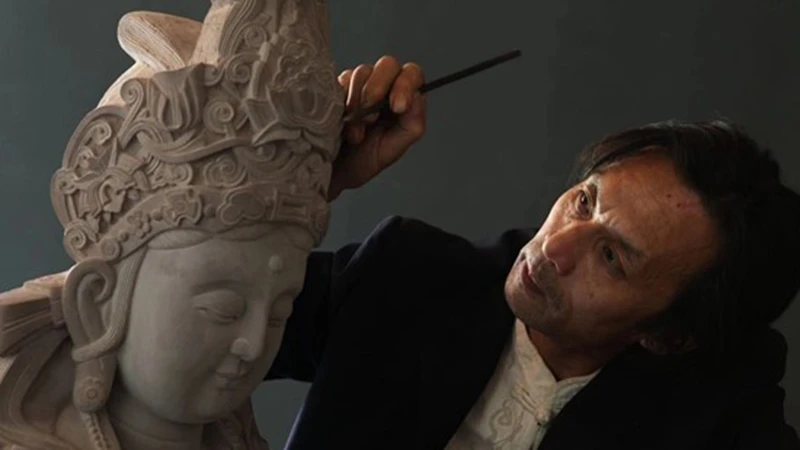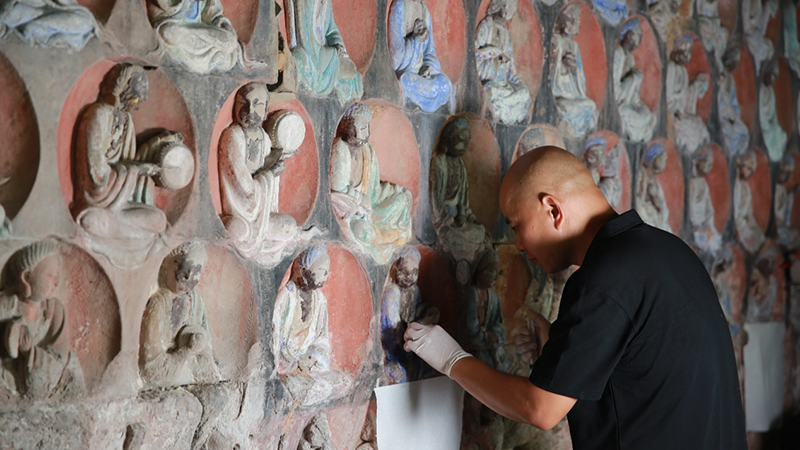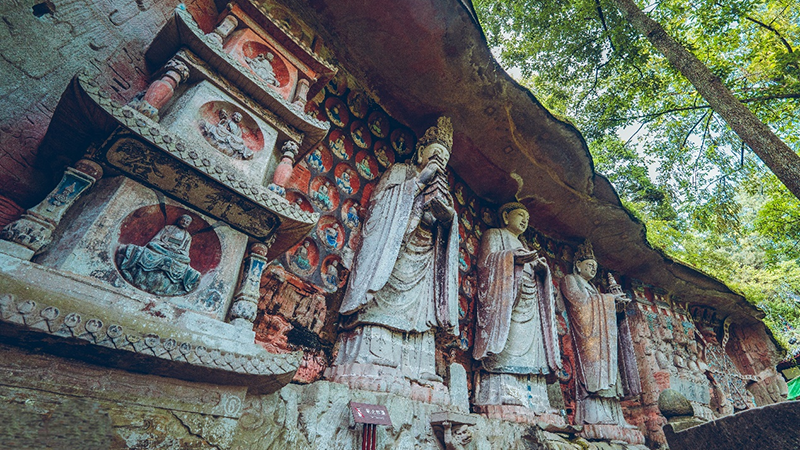In the realm of cultural preservation, a unique group of unsung heroes quietly works behind the scenes, painstakingly restoring and safeguarding ancient relics. Their job demands patience, skill, and an unwavering passion for history. One such example of their dedication is the restoration of the Thousand-Hand Guanyin (千手观音) statue from the Dazu Rock Carvings (大足石刻), a masterpiece that has withstood the test of time and nature for over 800 years.
The Silent Art of Cultural Preservation
Cultural heritage, particularly ancient stone carvings like the ones found in Dazu, faces constant threats from natural elements such as water damage, erosion, and biological growth. These forces, if left unchecked, would result in the irreversible loss of irreplaceable pieces of history. For individuals like Liu Xiaoyu (刘小雨), a cultural relics restorer, the task of preservation is not just a job; it is a lifelong commitment driven by passion.
Working on these relics often involves long hours of meticulous labor. In Liu’s case, he spends much of his time scrutinizing the surfaces of stone carvings, searching for signs of wear and damage. “Artifacts are not just cold, lifeless stones," he says. "They carry stories, and it’s our responsibility to give them a second life.” Liu, along with his colleagues, has dedicated years to restoring the Thousand-Hand Guanyin. This intricate work involves detailed treatments, often requiring standing for hours in awkward positions to ensure precision.
The process of restoration isn’t glamorous. It involves battling the harsh elements—whether enduring the stifling heat of summer or braving the cold in winter. Restorers like Liu must also master the delicate balance of handling chemical agents, avoiding insect bites, and working under uncomfortable physical conditions. Despite these challenges, their perseverance has enabled them to breathe life back into ancient sculptures and carvings that were once on the brink of decay.

SONY DSC
The Role of Technology in Cultural Preservation
In recent years, technology has significantly advanced the process of artifact restoration. Traditional tools like chisels and scalpels have been supplemented with modern equipment. Portable non-invasive diagnostic instruments allow for a quicker and more accurate assessment of an artifact’s condition. For instance, infrared thermography can now detect moisture damage in sculptures by measuring surface temperature distributions, which would otherwise be invisible to the naked eye. Instruments like rebound hammers and ultrasonic detectors measure the extent of erosion, ensuring that the restoration work is not just cosmetic but structural.
These technological innovations have empowered cultural restorers with a new set of "eyes" and "hands." Liu Xiaoyu shares that these advancements have made their work more efficient and accurate, allowing them to diagnose and treat the "illnesses" of cultural artifacts with precision. This new wave of technology has transformed what was once considered a laborious and time-consuming process into a more streamlined and effective endeavor. However, while technology is a powerful ally, the heart and soul of restoration work still lie in the careful, human touch of the restorers.
The Guardians of Heritage
At the core of cultural restoration is a profound respect for history and the people who created these works of art. It’s a job that requires more than just technical skill; it demands an immense amount of patience, passion, and reverence for the past. Liu Xiaoyu emphasizes that one cannot succeed in this field without a deep love for the work. “Without passion, you can’t sit on the cold bench,” he says, referring to the solitude and intense focus required for this labor-intensive work.
The restorers of the Dazu Rock Carvings are more than just preservationists; they are guardians of a culture that spans centuries. Their work ensures that future generations can continue to experience the beauty and significance of these ancient sculptures. For Liu, every inch of rock restored is a small victory, a step toward prolonging the life of the artifact. The joy of seeing an ancient sculpture regain its former glory is worth all the hardships endured.
Through their work, these restorers are creating a bridge between the past and the present, enabling the relics of history to engage in a dialogue with modern society. They are the silent guardians, ensuring that the cultural legacy of their ancestors remains vibrant and accessible in the future.
The Bigger Picture
Cultural heritage, including the Dazu Rock Carvings, represents more than just artistic or historical significance. It is a reflection of the nation's identity, its values, and its history. The preservation of these relics is about safeguarding the essence of a culture for future generations. It’s a responsibility that Liu Xiaoyu, and their fellow preservationists take very seriously. They recognize that these artifacts are not just objects to be admired; they are storytellers, carriers of a civilization’s collective memory.
In recent years, China has placed increasing emphasis on cultural preservation, recognizing the invaluable role that artifacts play in fostering a strong national identity. The resurgence of interest in the Dazu Rock Carvings, whether through their depiction in popular media or through public exhibitions, is a testament to the success of these efforts. For the guardians of these relics, the ultimate goal is not just to keep the sculptures intact but to bring them to life in the hearts and minds of the people.
The work of Liu Xiaoyu, and others like them will continue to be vital in ensuring that China's rich cultural heritage remains a living, breathing part of modern society. Their work is a delicate dance between tradition and innovation, preservation and transformation. In the end, they are more than just protectors of ancient stones; they are stewards of a legacy that binds past, present, and future.
As Liu Xiaoyu so eloquently puts it, “To choose one thing for life, to protect these relics, and to see them ‘come alive’—this is the meaning of our work.” Through their tireless efforts, these cultural guardians ensure that history not only survives but thrives, allowing future generations to continue their dialogue with the past.



